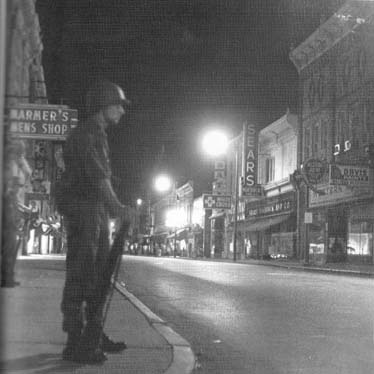
Cambridge Series | Oil Paintings
The Cambridge series of paintings were done to commemorate the May 13 - 15, 2011 60th reunion of the 1951 Cambridge High School class. As was earlier stated, Dr. Brown is a member of that class.
The series is dedicated to Mrs. Fran Applegarth.
Mid-twentieth century Cambridge was markedly different from the town of today. Then it was a major seafood and agricultural hub. The former, centered on Cambridge Creek packing houses such as Clayton's, involved processing oysters and crabs local watermen harvested from the Choptank and Little Choptank Rivers and Chesapeake Bay. The latter, centered on Phillips Packing Company, involved canning tomatoes and other produce harvested from farms throughout the Delmarva Peninsula.
By early twenty-first century standards, existence in 1940's - 1950's Cambridge was impoverished. The major means of transportation was walking, the major means of information and entertainment were radio, newspaper, books, an occasional movie and socializing. Communication was mostly by face-to-face contact, handwritten letters and telephones attached to a wire.
The economy was simple. Most townspeople were employed by Phillips Packing Company, were into farming or participated in the seafood industry. Those employment bases supported ancillary retail and services establishments ranging from shoe stores to physicians' offices to school teaching.
Few regarded themselves as impoverished. The waters were pure, producing seafood in abundance. Family farms grew tomatoes and other produce in abundance. The air was clean and fresh. "Home Run" Baker living in nearby Trappe was a big deal.
The poorest folk were the African-Americans. Racial segregation was strict and insidious. Unfortunately, the issue was resolved for Cambridge in a riotous manner abetted by outsiders. That has left a resentment that lingers to the present. However, it is a sad fact that for white children and youth of the time, racial segregation was part of the ethos, a non-issue.
The paintings that follow illustrate Cambridge as it was during the youth of Class of 1951 members. They are not paintings of obvious landmarks such as the post-office, churches or courthouse. Rather, the paintings emphasize life as it was then.
Recording any living history with a degree of accuracy is a daunting task. Memory is a notorious thief and liar. Memory discards, distorts, rationalizes, is altered by subsequence experience and re-forms to an extent that compromises the realities. Memory is not at all analogous to videotaping an event, it is more like trying to record events as an ink sketch on a slice of Swiss cheese.
The task is not hopeless, however. The historian can draw on shared or collective memories, media reports from the time, previous historical accounts and photographs.
Cambridge was fortunate in the latter regard. The renowned Baltimore Sun photographer A. Aubrey Bodine was enamored with Maryland's Eastern Shore, including Cambridge. He produced a legacy of 1930's through 1960's photographs that are important works-of-art in themselves. A visit to aaudreybodine.com is to see photography that is as-good-as-it gets.
Dr. Brown utilized all of the above to inspire him and to expand his imagination.
Herewith is Dr. Brown's tribute to the Cambridge High School Class of 1951:
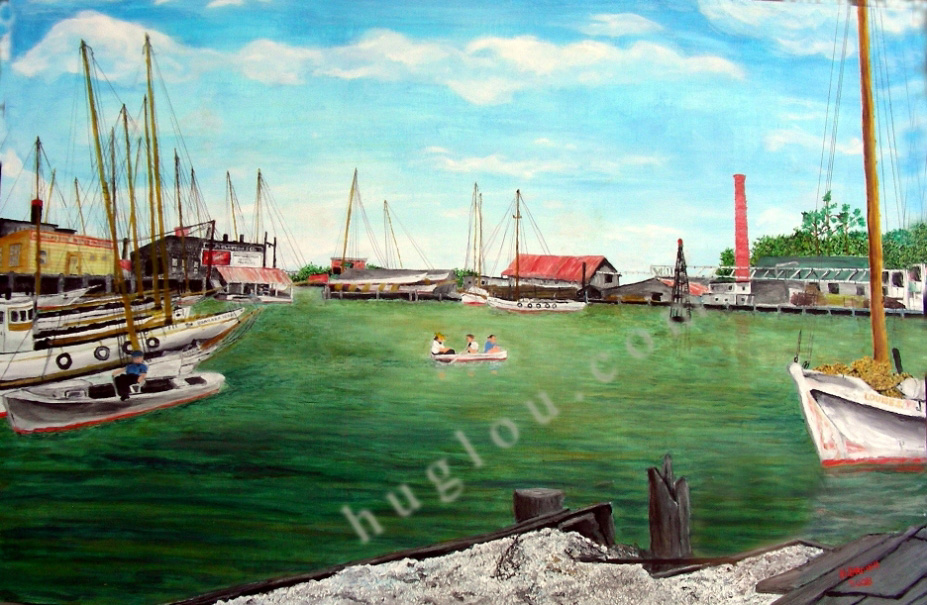
UP THE CREEK
Cambridge Creek, an off-shoot of the Choptank River, was the hub of the seafood industry. It's shores were lined with crab and oyster packing houses, shipyards and related facilities. The Creek was home port to the fishing boats which were almost all sail powered. The Creek divided the town into East and West Cambridge, the two connected by a bridge. Today, the Creek shores are lined with condominiums. A. Aubrey Bodine's photo is a "classic".
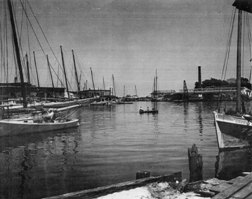
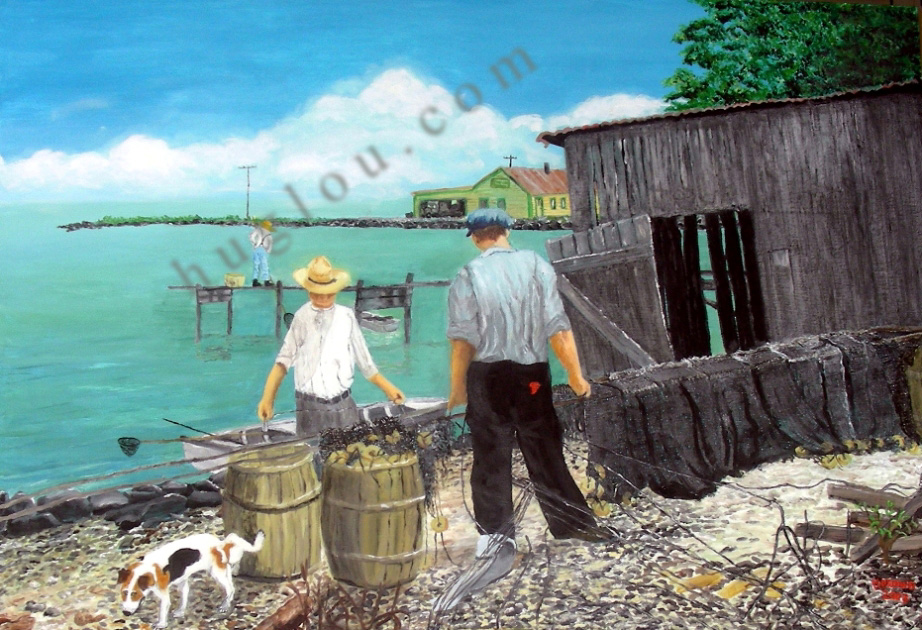
NETMINDERS
Net making and repairing required skilled artisans. The nets were essential to commercial fishermen who harvested croakers, rockfish and perch from the Choptank River and Chesapeake Bay. They overfished to the extent the industry is no longer viable. The painting is another inspired by an A. Aubrey Bodine photo. One that is a work-of-art in itself and widely exhibited.
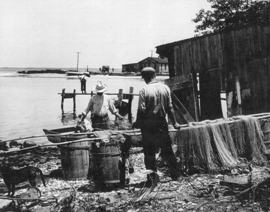
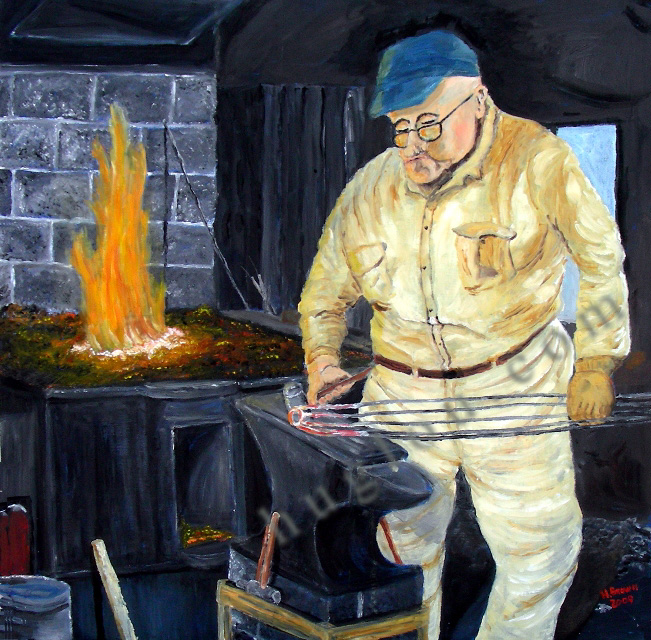
TONGMAKER
Mr. Joseph Brocato was a blacksmith who manufactured and repaired oyster tongs. Oyster tongs are long-handled rake-like devices used to remove oysters from beds. The painting was inspired by A. Aubrey Bodine's photo of Mr. Brocato.

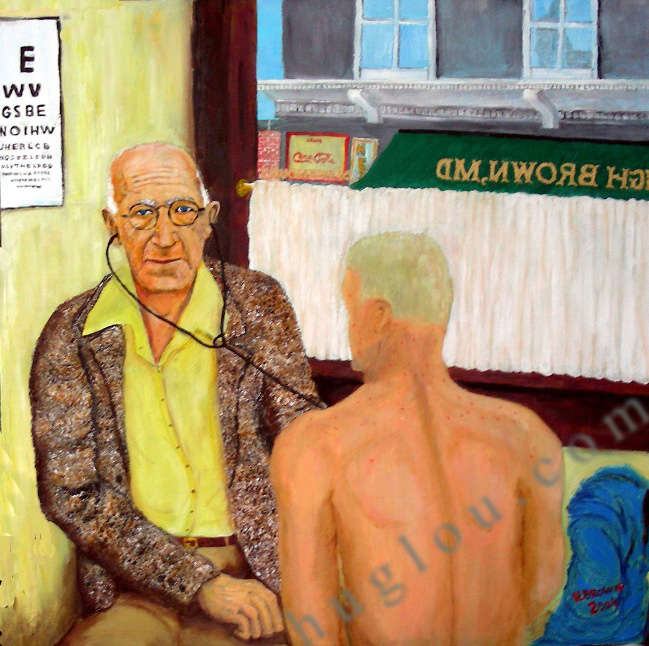
MEASLES: PORTRAIT OF THE ARTIST'S FATHER
The Artist's father practiced medicine from a storefront on Cambridge's main street for many years. At that time, physicians did not need office staff, there were no appointments needed and house calls were routine 24/7.


TOMATO LOADER
The agricultural hub of Cambridge was produce packing houses that primarily packed tomatoes. In season the industry was a major employer, needing personnel that ranged from manual laborers to laboratory technicians. Another A, Aubrey Bodine photo served as inspiration for the painting.

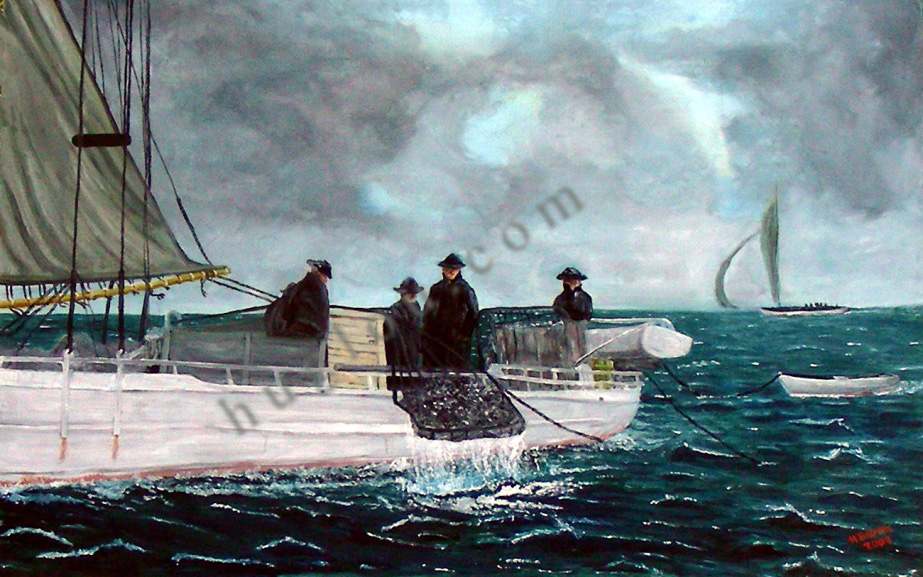
CHOPTANK OYSTER DREDGING
Along with tonging, dredging was a method for harvesting oysters. By law, dredging could only be done under sail -- no motorboats allowed. Thus, a good wind was necessary. The oystermen appear almost priest-like in both A. Aubrey Bodine's photo and the painting.


GENERAL STORE
A. Aubrey Bodine's photo was taken in Crisfield but such stores were replete in the segregated sections of most Eastern Shore towns, including Cambridge, in the 1940's - 1960's.
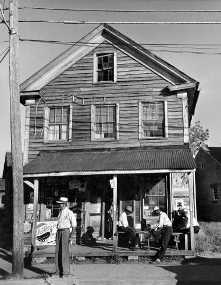

HARBOR
A. Aubrey Bodine titled his photo "Cambridge Harbor." It is actually a view on the Creek.
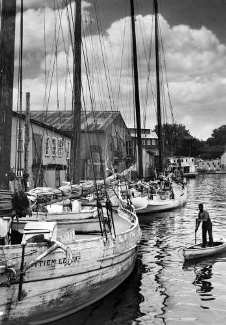

SOFT SHELL CRABBING
The Choptank River Bridge was a low, narrow two-lane roadway with the center span being a drawbridge. It has since been replaced by a four-lane higher bridge. Molting crabs hide in seaweed until the new shell hardens. They are routed out and captured with crab nets.
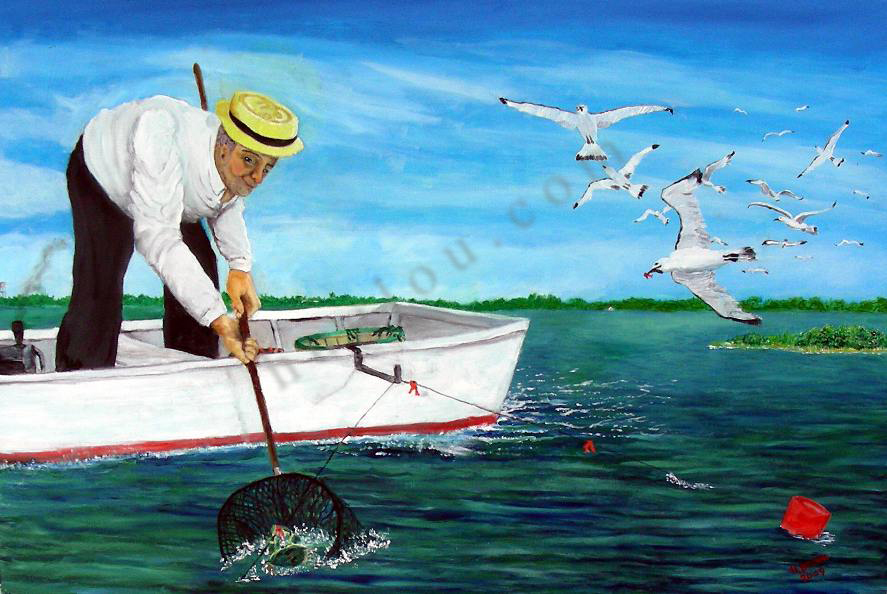
ROOSTER ISLAND TROT LINE
Hard shell crabs were caught with a baited trotline. A popular site for running a trot line on the Choptank River was off Rooster Island. The Island was also a notorious trysting place for pleasure boaters. Rooster Island no longer exists.
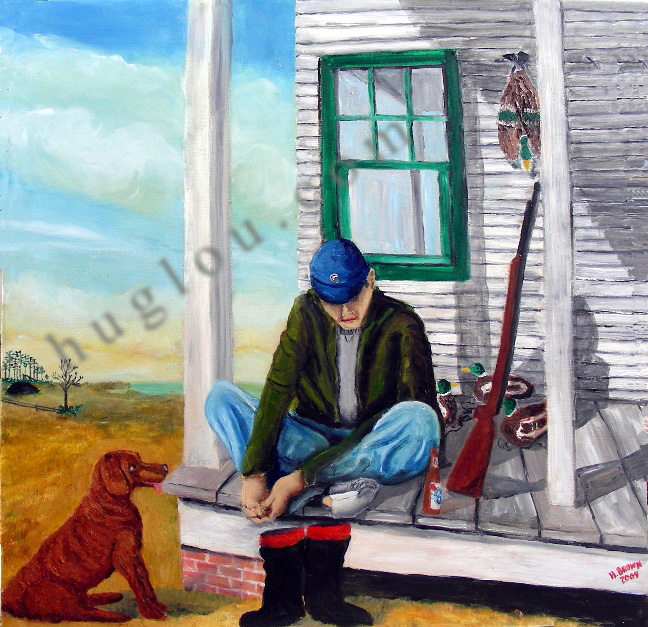
DUCK HUNTER CONTEMPLATING HIS BIG TOE
The dog is a Chesapeake Bay retriever.

BUCKTOWN CHURCH
The church building located in the Bucktown section of Cambridge is also known as the Bazzel Church and The Church in the Woods. It was built in the early 1800's by and for slaves.
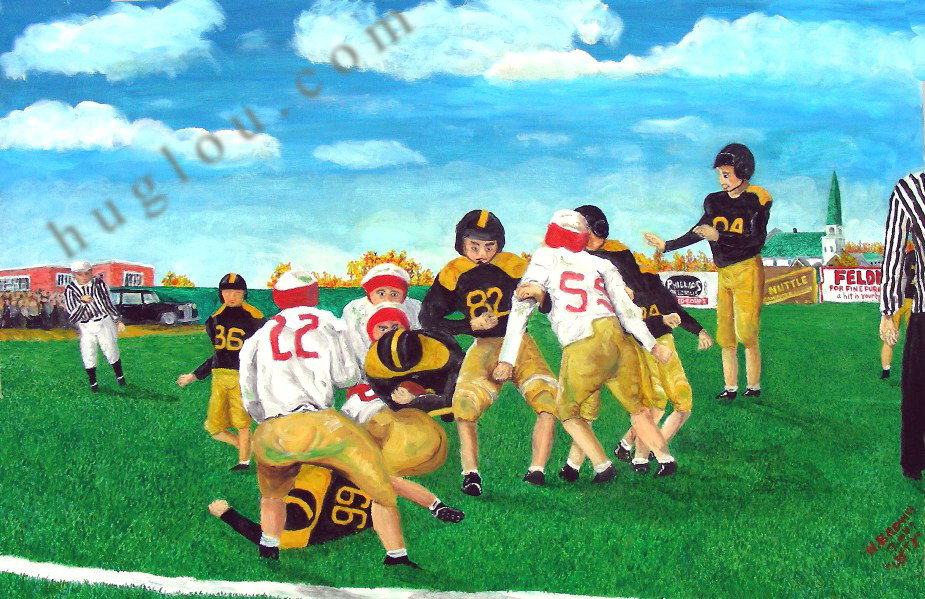
HIGH SCHOOL FOOTBALL
In the 1949 - 1950 school year, Cambridge High School started a varsity football team. Games were played on Friday afternoons. Classes would be let out early so students could attend. In later years when a lighted field was available, games were played on Friday nights. The painting was inspired by a photo the Artist took as part of his assignment as school paper photographer.
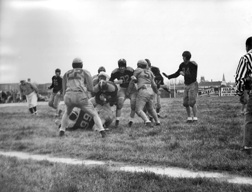
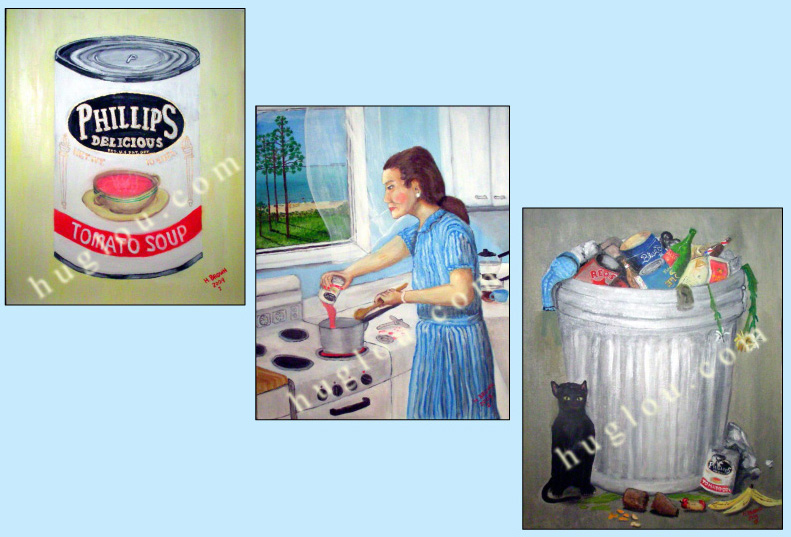
LIFE AND DEATH OF A SOUP CAN
Andy Warhol's pop art was taken a step further with creation of a triptych. The Phillips Delicious brand was an integral part of Cambridge throughout the 1940's - 1950's.
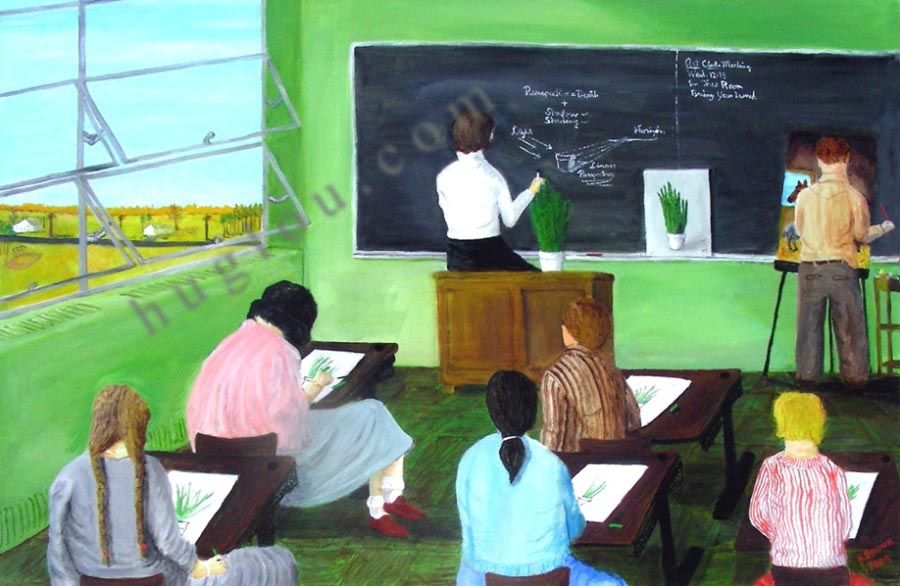
10A ART CLASS (C) LATE 1940's
Art Class in the late 1940's
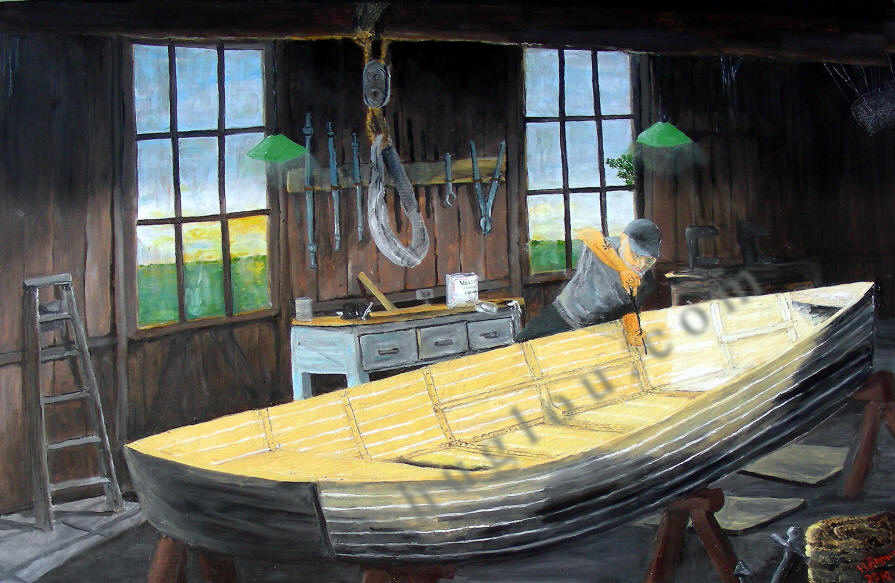
BOAT BUILDER
Most modern boats are constructed from synthetic materials such as fiberglass. In the 1940's and 1950's, most were made of wood. The builder depicted here has created a small flat bottomed skiff which he started to paint before finding an errant screw that needed tightening. When he finishes painting the shell, he will install the seats and a small Briggs and Stratton motor.
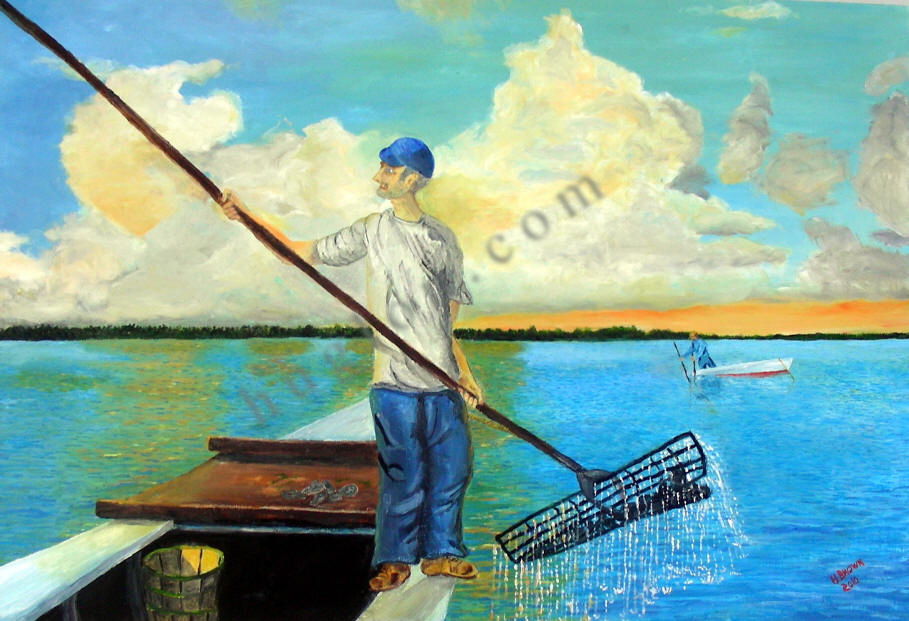
CHOPTANK OYSTERMAN
Strength and agility are the attributes needed to harvest oysters with tongs. Some tongs have handles as long as 16 feet. The catch is placed on a culling board where undersized oysters, shells and other debris are returned to the water.
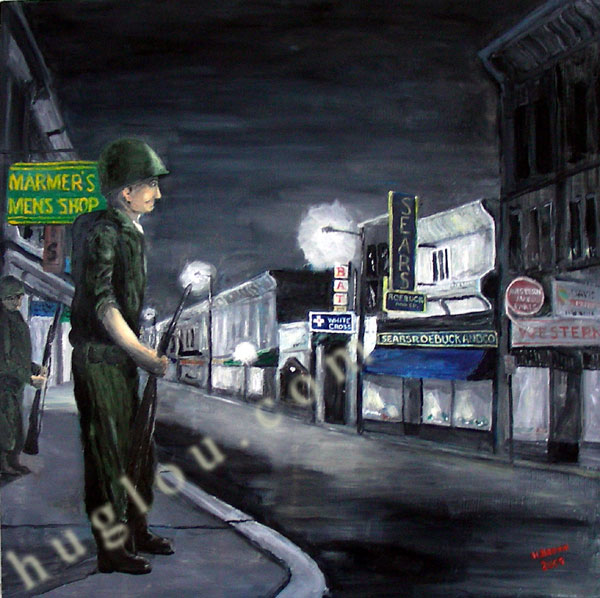
1967
Arguably, Cambridge in the 1940's - 1950's was a "Norman Rockwell", all-American place. Simple in the good sense of the word, and, relative to the present, innocent. That was because of the town's geographical, intellectual and cultural isolation. It was both innocent and isolated.
That purity was blemished in only one respect. Racial segregation.
Today, Cambridge is no longer innocent nor isolated nor segregated. Many factors caused those changes. Overfishing and pollution doomed the seafood industry, agri-business effected the loss of small farms and local vegetable packing, the communications revolution brought education and sophistication, exodus of the town's youth to greater world opportunities, the "discovery" of Ocean City and the Eastern Shore by the Washington Beltway minions were some of those factors.
Most significantly was the changing National ethos in the 1960's; America would never be the same after that decade, nor would Cambridge. In the 1960's the singular or iconic event that signaled the town's loss of innocence and isolation occurred July 29, 1967 when a radical named H. "Rap" Brown came to Cambridge and gave a speech that inspired racial riots.
"Violence is as American as cherry pie," he told a crowd who hours thereafter exchanged gunfire with authorities and burned down the black business section and a school. Maryland Governor Spiro Agnew declared martial law and sent in the national guard.
The painting was inspired by a news photo of that event. It is the final painting in the series.
